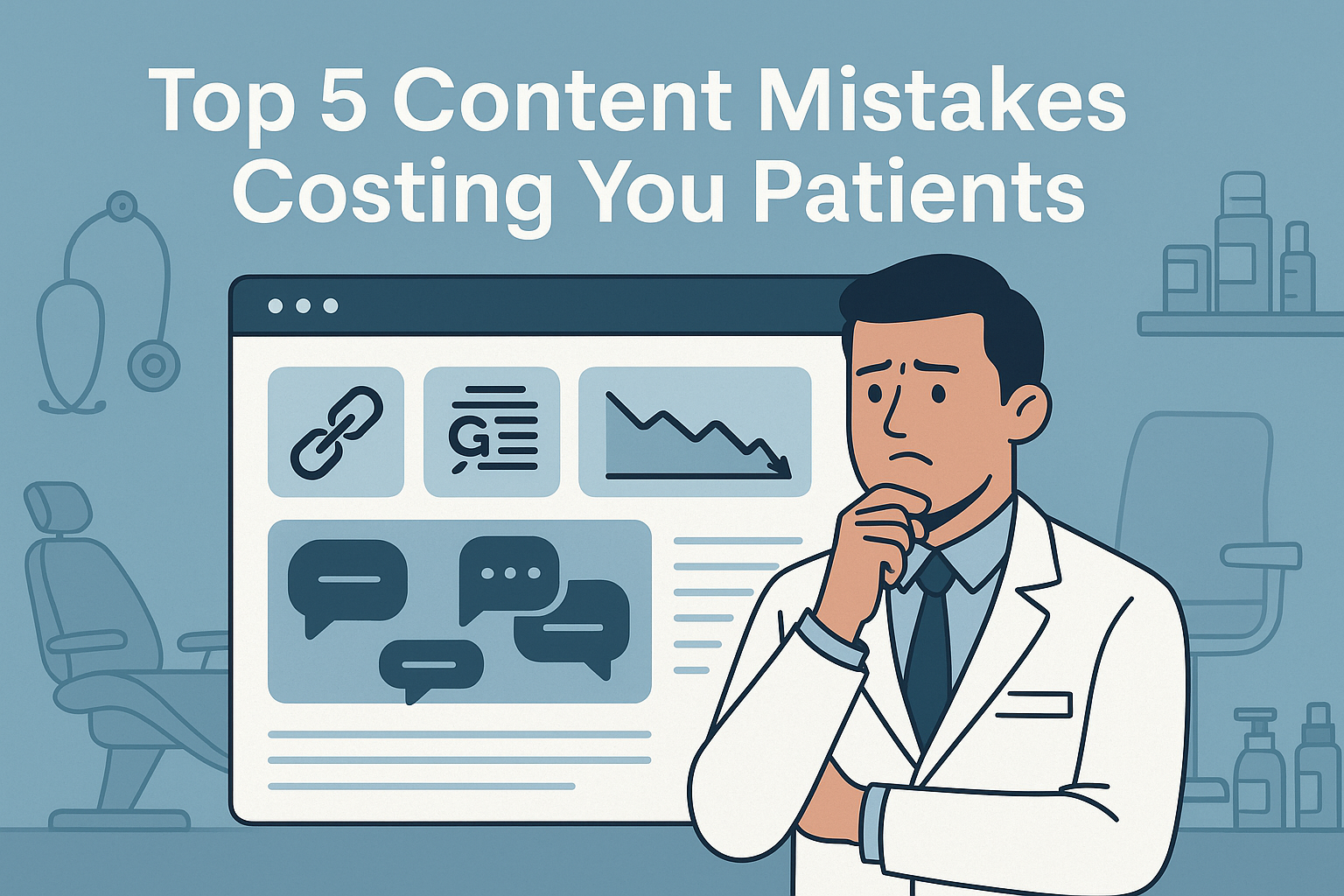Top 5 Patient-Focused Authority Content Mistakes (And How to Avoid Them)
If your content isn’t bringing in qualified patients, it’s not just underperforming. It’s quietly costing you revenue, reputation, and long-term growth.
Building Trust Is Like Building a Bridge
Picture your content as a bridge between your expertise and your ideal patient. That bridge should be strong, seamless, and inviting. But if it’s full of weak planks like keyword stuffing, irrelevant topics, or a generic voice, patients won’t cross it. They’ll bounce off your site and land with a competitor who seems to “get” them better.
In this post, we’re revealing the five most common authority content mistakes private practices make, and how you can fix each one to start attracting more of the right patients. Let’s get into it.
1. Writing for Google Instead of Real People
You’ve probably heard the phrase “content is king.” But let’s be honest. If your content is just a wall of keywords or generic blog fluff, it’s not doing anything for your patients or your practice.
Too many providers rely on SEO writers who don’t understand their industry. The result? Articles that technically rank, but feel flat, cold, or robotic. Patients don’t stick around because they don’t feel understood.
Fix it: Pair SEO best practices with human language. Use tools like SurferSEO or Clearscope to optimize structure, but keep the tone warm, clear, and focused on patient concerns. Write like you would explain something during a consultation.
Did you know?
88% of health seekers start with a search engine, but only 14% trust what they find without further validation (Pew Research).
Industry insight:
“Just because it ranks doesn’t mean it converts. Real authority content educates and builds trust.” – Neil Patel
2. Ignoring Local Patient Intent
You could have the best-written blog on Invisalign or microneedling, but if it doesn’t speak to patients in your area, you’re invisible to the people who matter most.
Google heavily favors local content. If your blogs and service pages don’t clearly signal your location or serve nearby search intent, your content will rank for all the wrong reasons, or not at all.
Fix it: Naturally weave your city, neighborhood, or region into headlines, subheadings, and patient examples. Include phrases like “family dentist in Phoenix” or “Vancouver skin rejuvenation options” where it makes sense.
Did you know?
Nearly half of all Google searches are looking for local information (GoGulf).
Industry insight:
“Local SEO isn’t optional. It’s the backbone of private practice marketing.” – Joy Hawkins
3. Talking Features Instead of Results
You may be proud of your new device or advanced training, and rightly so. But most patients don’t connect with features. They want to know how your service will change their life, or at least make them feel better in their skin.
Content that focuses on tools instead of outcomes often fails to convert. Your website should make potential patients see themselves in the transformation you provide.
Fix it: Lead with patient-centric benefits. Use storytelling, testimonials, or before-and-after examples to show how your treatment improves someone’s appearance, confidence, or health.
Did you know?
Content with patient success stories generates five times more engagement than feature-based content (Content Marketing Institute).
Industry insight:
“Sell the hole, not the drill.” – David Ogilvy
4. Creating Random Blog Posts Without a Strategy
Publishing content just to check a box is one of the fastest ways to waste your time and budget. Random posts with no structure or journey behind them might as well not exist.
Every piece of authority content should serve a purpose. Whether it’s attracting new visitors, guiding them to book, or educating them before a consultation, your content should move them along a clear path.
Fix it: Use a content calendar based on the patient journey. For example:
- Awareness stage: “What causes adult acne?”
- Consideration stage: “Top acne treatments in Denver”
- Decision stage: “Before & after: Our acne scar results in real patients”
Link these pieces together to guide readers from curious to converted.
Did you know?
Businesses with a documented content strategy are over three times more likely to report success (CoSchedule).
Industry insight:
“Without strategy, content is just stuff. The world has enough stuff.” – Arjun Basu
5. Not Using Your Own Voice and Authority
You’ve built your career on being a trusted provider. So why let your website sound like it was written by someone who’s never stepped inside a clinic?
Too often, providers outsource their content and strip it of their unique voice. But patients want to hear from you. They want to know who you are, what you stand for, and why you’re different from the practice down the street.
Fix it: Add a section to your blog or website where you speak directly to patients. This could be a “Doctor’s Perspective” series, FAQ videos, or even a note from the founder. Use your voice to build connection and trust.
Did you know?
Content authored by medical professionals sees double the engagement compared to ghostwritten content (HubSpot Health).
Industry insight:
“Authority comes from owning your voice, not outsourcing your credibility.” – Ann Handley
Final Thoughts: Your Content Is More Than Just Marketing
If your authority content isn’t bringing in steady leads, it’s not a lost cause. It’s a sign that something needs to be realigned. From improving your local relevance to creating patient-first messaging, small tweaks can lead to major results.
Your content is your first impression. It’s your handshake before the patient ever picks up the phone. When done right, it builds trust, improves search visibility, and drives revenue — all while you focus on what you do best.
Parting thought:
Build your content like you build your treatment plans — with precision, purpose, and patient outcomes in mind.


